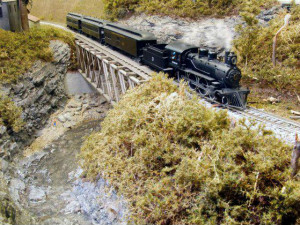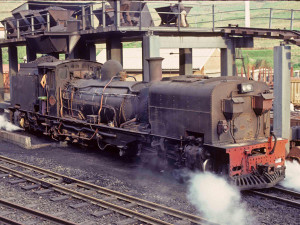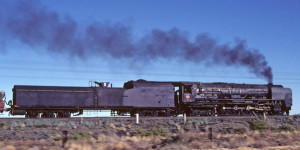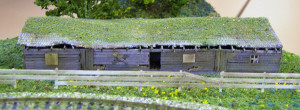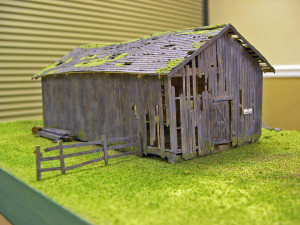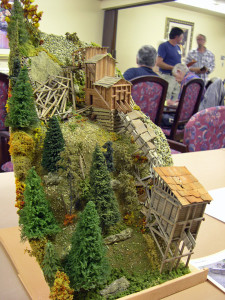Gordon Garnhart
There were 20 people gathered on Wednesday, September 14th for a visit to Dr. Nick Muff’s fabulous layout. Most folks start a layout by working toward operating as soon as they can. Then they fill in the scenery and details as time permits. Nick has taken the opposite approach. He has, in HO scale, reproduced in exquisite detail, the main passenger depot in Kansas City, Missouri, of the Kansas City Southern Ry. and the surrounding infrastructure.
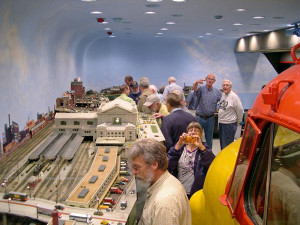
General view of passenger station and adjacent trackwork. Viewers include Steve Jaffray, Susan Gonzales (taking a photo), John White (back to camera), Dan Gould and Harvey Abrams. Dr. Muff is in green shirt just beyond roof of station. A portion of the real F-7 cab is visible at right.
In his own words Nick says, “This is a landmark year for my model Kansas City Southern/Kansas City Terminal Railway layout. Long past are the days of cement, plumbing, house electrical, insulation and wallboard. Also past are the bench work, control panels, wiring and track work. This month marks the completion of structures, scenery and detailing on the existing portion of the railroad. Last to be completed were the structures and detailing of the roundhouse, coach yard and locomotive servicing facilities. I have long admired the purposeful ‘clutter’ of the roundhouse area on John Allen’s G&D. Detailing around the
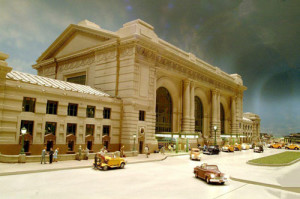
Front view of station
roundhouse area was done with his work in mind, a tribute to the ‘Wizard of Monterey.’”
To this, Al Frasch adds, “And this month also marks the transition to the mainline portion of the layout, yet to be constructed. It will take a little while to regroup, and prepare the construction site. Then work will begin on a two level section of
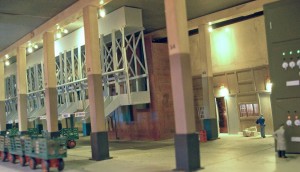
One of the two lower levels below the station
the layout passing from Grandview, Missouri through western Arkansas to the return loop and Union Station at Shreveport, Louisiana.”
These photographs, taken by Al Frasch, clearly show the meticulous detail that abounds on Nick’s layout. The city streets have lighted streetlights and traffic signals, and the many vehicles have illuminated headlights and
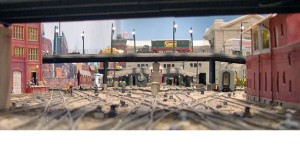
One of the throats to the passenger station trackage
taillights. And not only has he done an impressive job on treating the exteriors of buildings, but many of the structures are beautifully fitted with lighted interiors showing store fronts, office workers and other details. The huge passenger terminal is lighted by elaborate chandeliers, and people can be seen hurrying across the marble floors. It is awesome and inspiring to any model railroader.
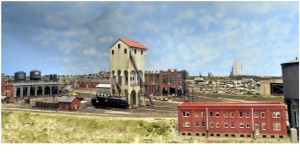
Locomotive service area
Nick’s Kansas City Southern/Kansas City Terminal Railway layout is featured in the August 2011 edition of the Model Railroad Hobbyist online magazine which is available at: http://model-railroad-hobbyist.com/. This is a FREE magazine that you can either download and view on your favorite PDF view program or read online in your favorite browser. The article finishes a trilogy of layouts by members of the Skagit Valley & Whidbey Clinic. If you haven’t taken a look yet, check out the May 2011 issue for Jack Tingstad’s Cloud City & Western, and the July 2011 issue for Al Frasch’s Pilchuck Division of the BNSF. You can also view videos concerning the layouts.
Next month, on Wednesday, October 12th at 7:00 PM we will return to the Summer Hill Retirement Center for an unusual program that promises to be interesting, entertaining and informative. A panel of “experts” will be assembled, and will try to answer any and all of your model railroading questions.

